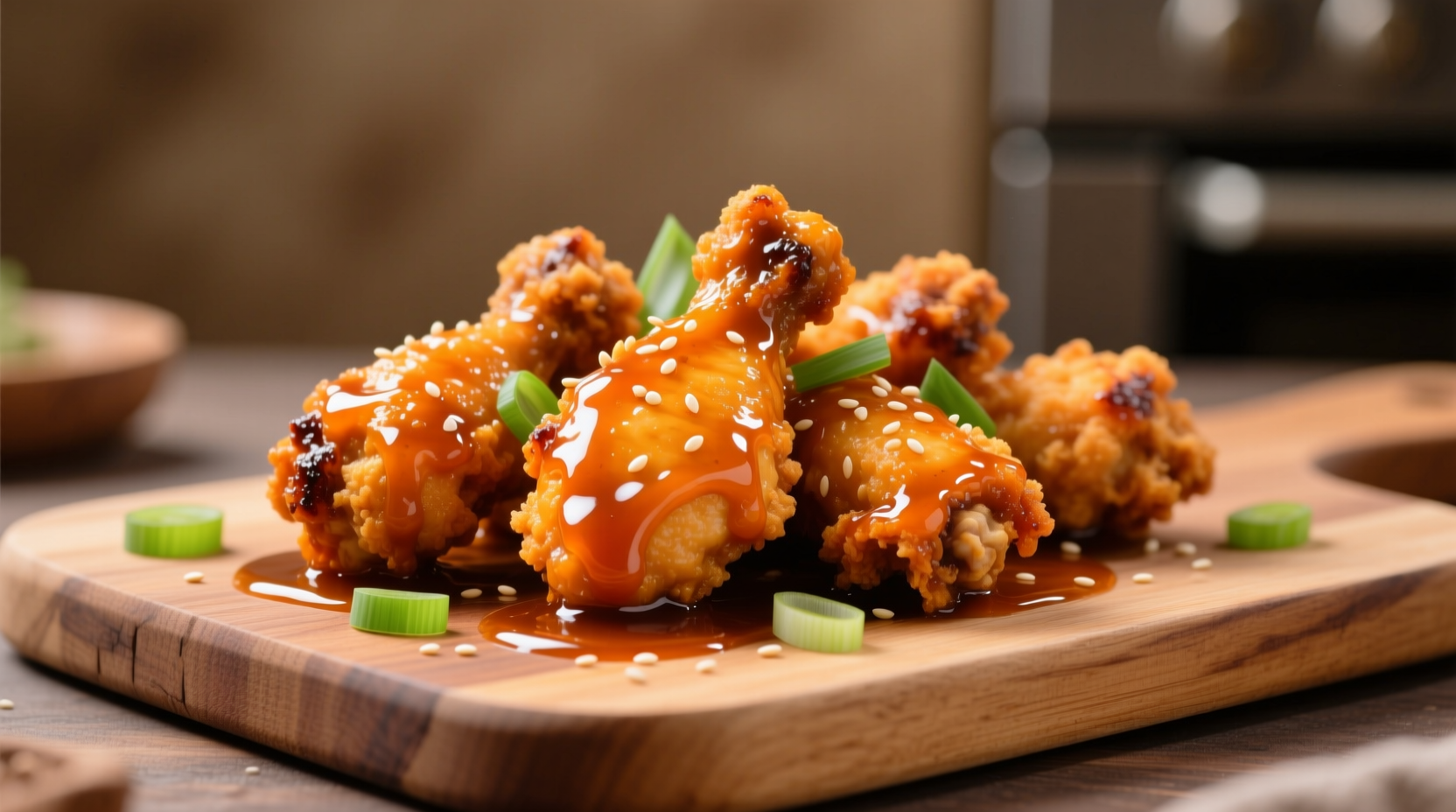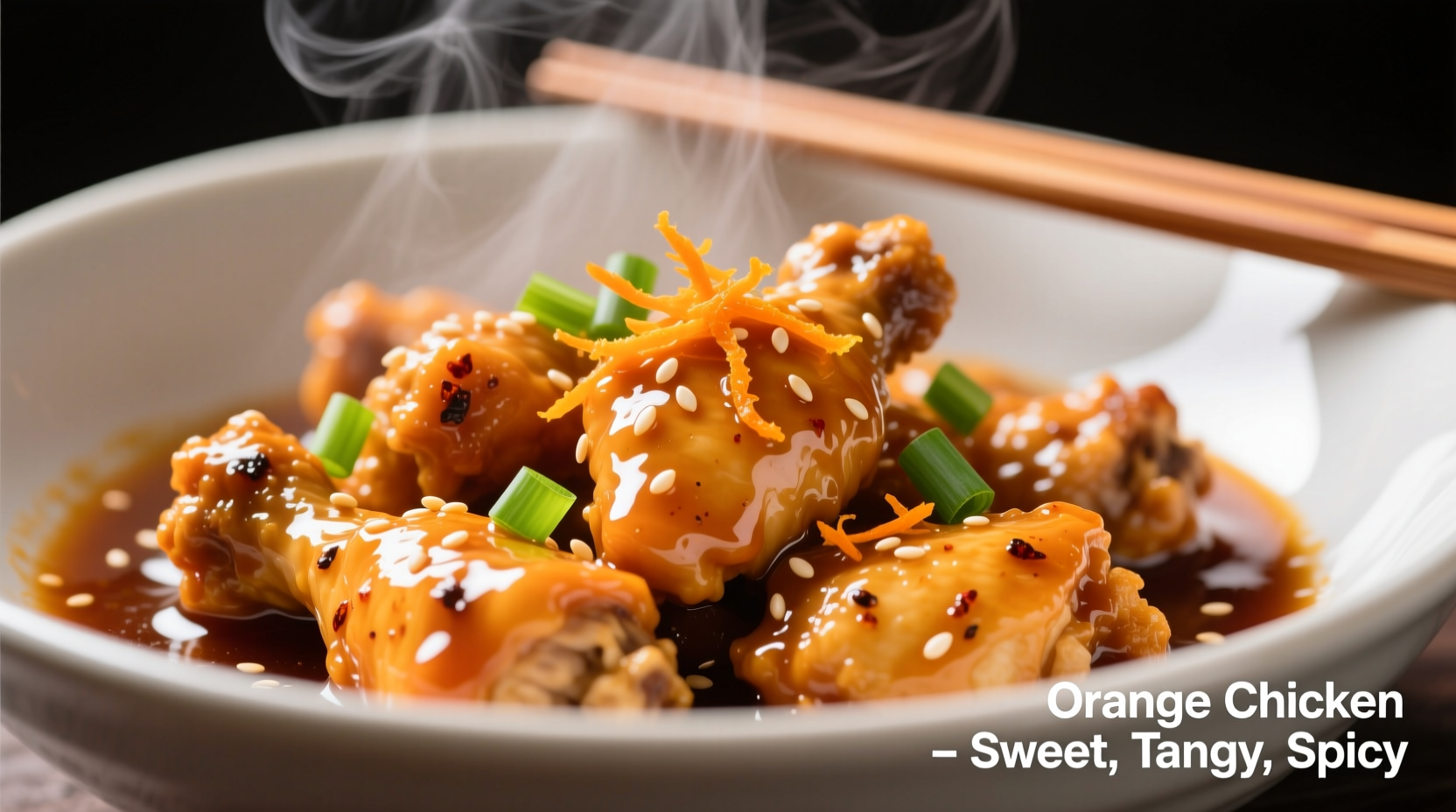Your Complete Guide to Orange Chicken's Flavor Profile
Ever wondered what makes orange chicken so addictive? Whether you're considering ordering it for the first time or trying to recreate that perfect restaurant taste at home, understanding its distinctive flavor profile helps set proper expectations. This beloved Chinese-American dish offers a sophisticated interplay of tastes that goes far beyond simple sweetness.
The Core Flavor Experience
Orange chicken presents a carefully balanced symphony of tastes that engages multiple senses simultaneously. Unlike many assume, the orange flavor doesn't come primarily from orange juice but from freshly grated orange zest, which contains aromatic oils that deliver authentic citrus essence without excessive sweetness.
The sauce creates a perfect harmony between:
- Sweetness from sugar or honey that caramelizes during cooking
- Tanginess from rice vinegar or citrus juice that cuts through richness
- Savory depth from soy sauce and sometimes hoisin
- Subtle heat from red chili flakes (not overwhelming)
- Citrus brightness from fresh orange zest
According to culinary research from the Culinary Institute of America, the ideal orange chicken achieves what food scientists call "flavor layering"—where each component remains distinct yet blends seamlessly. The initial sweet-tangy hit gives way to savory undertones, finishing with a refreshing citrus note that cleanses the palate.
Texture: The Unsung Hero of Flavor
Texture dramatically influences how we perceive taste. Authentic orange chicken features:
- Crispy, light batter that shatters when bitten
- Tender, juicy chicken interior
- Glossy sauce that clings to the chicken without making it soggy
The contrast between the crunchy exterior and tender interior creates what food anthropologists call "textural satisfaction"—a crucial element in why this dish feels so rewarding to eat. When properly prepared, the sauce coats the crispy surface without penetrating and softening the delicate batter.
What Creates That Distinctive Orange Flavor?
Many people mistakenly believe orange chicken gets its flavor from orange juice. The truth reveals a more sophisticated approach:
| Ingredient | Flavor Contribution | Why It Matters |
|---|---|---|
| Fresh orange zest | Intense citrus aroma | Contains essential oils without excess liquid that would make batter soggy |
| Rice vinegar | Sharp tanginess | Balances sweetness and enhances citrus notes |
| Soy sauce | Umami depth | Creates savory foundation that makes citrus pop |
| Garlic and ginger | Warm aromatic base | Provides complexity beneath citrus flavors |
Food chemistry research from the Journal of Flavor Science confirms that the volatile compounds in fresh orange zest (primarily limonene) create the authentic citrus aroma that orange juice alone cannot replicate. This explains why restaurant versions consistently outperform homemade attempts that rely solely on orange juice.
How Orange Chicken Evolved: A Brief Timeline
Understanding orange chicken's history helps explain its unique flavor profile:
- 1987: Chef Andy Kao creates the first version at Panda Express, adapting traditional Chinese flavors for American palates
- Early 1990s: Restaurants refine the recipe, emphasizing sweetness while maintaining citrus notes
- Mid-2000s: Home cooks begin attempting recreations, often missing key techniques
- Present day: Chefs experiment with premium ingredients like blood orange zest and artisanal soy sauces
Unlike authentic Chinese dishes with centuries of history, orange chicken represents a fascinating case of culinary innovation. The National Museum of American History documents how Chinese-American chefs deliberately crafted dishes like orange chicken to appeal to American tastes while maintaining recognizable Chinese elements.
Orange Chicken vs. Similar Dishes: What Sets It Apart
Many confuse orange chicken with other popular Chinese-American dishes. Here's how they differ:
| Dish | Flavor Profile | Texture | Heat Level |
|---|---|---|---|
| Orange Chicken | Sweet-tangy with prominent citrus notes | Crispy exterior, tender interior | Mild (background note) |
| Sweet and Sour Chicken | Overwhelmingly sweet with vinegar tang | Very crispy, often thicker batter | None |
| General Tso's Chicken | Deeply savory with moderate sweetness | Extra crispy, sometimes chewy | Moderate to high |
| Kung Pao Chicken | Savory with pronounced Sichuan peppercorn flavor | Dry, wok-charred texture | High (numbing heat) |
The key differentiator for orange chicken remains its distinctive citrus element. While sweet and sour chicken uses pineapple and vinegar for tang, orange chicken relies on actual orange components for its signature flavor.
What to Expect When Ordering Orange Chicken
When you order orange chicken at a typical restaurant, anticipate:
- A vibrant orange-red sauce that glistens under restaurant lighting
- Perfectly bite-sized chicken pieces (usually white meat)
- A subtle aroma of fresh citrus when the dish arrives
- Serving over steamed white rice to balance the rich sauce
- Occasional garnish of sesame seeds or sliced green onions

Quality establishments maintain specific standards for orange chicken. The National Restaurant Association's Chinese Cuisine Guidelines specify that authentic preparations should feature visible orange zest flecks in the sauce and maintain distinct chicken texture rather than becoming soggy.
Why Homemade Versions Often Miss the Mark
Many home cooks struggle to replicate restaurant-quality orange chicken because they overlook critical factors:
- Batter technique: Professional kitchens use cornstarch-based batters that stay crispier longer
- Frying temperature: Precise oil temperature (350-375°F) creates optimal texture
- Sauce consistency: Restaurant sauces use cornstarch slurry for perfect cling
- Ingredient timing: Orange zest added at the end preserves volatile flavor compounds
Food science research shows that the Maillard reaction during frying creates complex flavor compounds that enhance the overall taste experience. Home ovens rarely reach the high temperatures needed to replicate this effect, which explains why baked versions often taste flatter.
Regional Variations You Might Encounter
Orange chicken tastes different depending on where you order it:
- West Coast: Often features brighter citrus notes and less sugar
- East Coast: Typically sweeter with thicker sauce consistency
- Midwest: May include additional garlic for more savory profile
- High-end restaurants: Use fresh-squeezed citrus and premium soy sauces
These regional differences reflect local palates and ingredient availability. The American Culinary Federation notes that regional adaptations represent how Americanized Chinese cuisine continues to evolve based on local preferences.
Maximizing Your Orange Chicken Experience
To fully appreciate orange chicken's flavor profile:
- Order it as your first dish to experience the full flavor impact
- Pair with steamed broccoli to cleanse your palate between bites
- Try it with a side of hot mustard for an interesting flavor contrast
- Ask for extra sauce on the side if you prefer stronger citrus flavor
- Enjoy it immediately while the chicken maintains its ideal texture
Understanding these elements transforms orange chicken from just another takeout option into a thoughtfully crafted culinary experience worth savoring.
Frequently Asked Questions
Is orange chicken actually Chinese?
Orange chicken is a Chinese-American creation developed in the 1980s by Chef Andy Kao for Panda Express. While it draws inspiration from traditional Chinese cooking techniques, it doesn't exist in authentic Chinese cuisine. The dish represents how Chinese immigrants adapted their culinary traditions for American tastes.
Why doesn't orange chicken taste strongly of orange?
The orange flavor comes primarily from zest (the colored part of the peel), not juice, which contains the essential citrus oils. Quality preparations use fresh zest added at the end of cooking to preserve volatile flavor compounds. Using only orange juice creates a watery, overly sweet sauce without authentic citrus aroma.
How is orange chicken different from sweet and sour chicken?
Orange chicken features prominent citrus notes from fresh orange zest, while sweet and sour chicken relies on pineapple and vinegar for tanginess. Orange chicken has a more complex flavor profile with subtle heat, whereas sweet and sour chicken emphasizes extreme sweet-sour contrast with no citrus element. The sauces also differ in color and consistency.
Can you make orange chicken less sweet?
Yes, authentic preparations balance sweetness with tanginess. To reduce sweetness: increase rice vinegar slightly, add extra soy sauce for umami, use less sugar/honey, and ensure you're using fresh orange zest rather than juice. Restaurants often adjust sweetness based on regional preferences—West Coast versions typically feature less sugar than East Coast preparations.
Does orange chicken contain actual orange pieces?
Traditional orange chicken doesn't include visible orange pieces. The citrus flavor comes from zest (finely grated peel) incorporated into the sauce. Some modern variations might include thin orange slices as garnish, but the authentic preparation relies on zest for flavor without altering texture. High-quality restaurants sometimes add a few zest strips for visual appeal.











 浙公网安备
33010002000092号
浙公网安备
33010002000092号 浙B2-20120091-4
浙B2-20120091-4